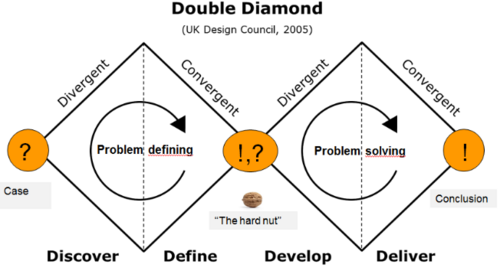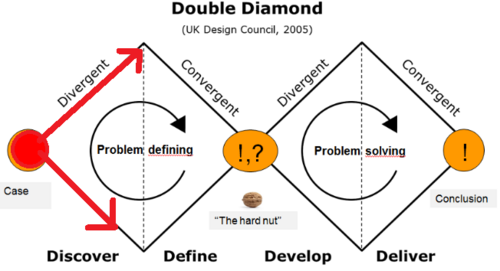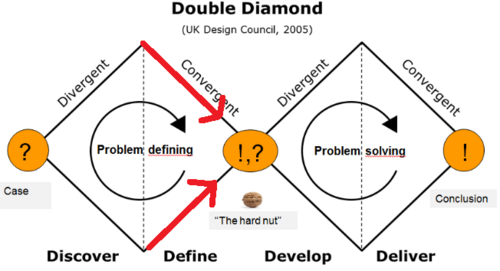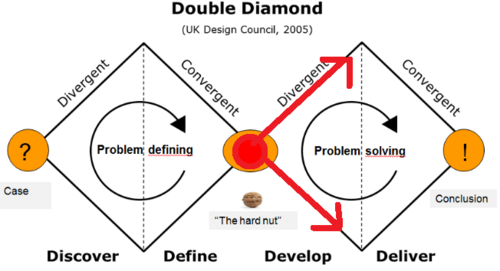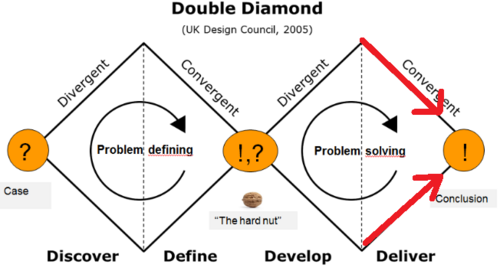The Double Diamond Tool: An efficient Project Management Tool
Developed by Wail Atrari
Abstract
This article will shed a light on a management tool called the Double Diamond process. The Double Diamond process covers a wide area of the problem-solving process. From discovering the initial problem to presenting a solve for this problem at the end of the process.
When managers are given a specific problem to solve, many managers quickly move on to the problem-solving phase, and try to solve that specific problem.[1]
This can result in the solution being only a temporary solution or being a solution to the wrong problem. And the reason for that, can be that not enough time has been spent on reviewing the actual problem and whether this problem is eligible. In other words, whether the so-called problem is the actual root of the problem. And this is where the Double Diamond tool will come in handy.
The Double Diamond tool was created by the Design Council in 2005, and consists of four smaller phases, which are utilized by special methods of thinking: Divergent and Convergent thinking, which this article will cover.
The Double Diamond tool explores the problem to discover if the implied problem is the actual root problem or just a consequence of another problem. The Double Diamond tool forces the user to spend time on exploring the problem definition phase in order to discover the very source of the problem, before moving on to the problem-solving phases, which ensures that the correct problem is found and solved.[2]
This article will describe the Double Diamond tool in detail, as well as give a step-by-step guideline on how a manager of a project can apply this tool, in conjunction with other models and tools, in their projects.
Contents |
Introduction
The Double Diamond tool was developed in 2005, by a British organization called Design Council. The Double Diamond tool was the product of a research that had been conducted to observe the design process of some of the leading companies. The leading companies’ way of operating in the design processes had some similarities, and based on that research, The Double Diamond tool was invented.[3]
The Double Diamond tool is a powerful management tool that can be used in many situations and examples, and thus offer a flexible but still a very innovative way to handle management problems, obstacles, and challenges. The Double Diamond is a tool that motivates the user to think outside of the box, in a creative and innovative way, and thus explores new methods and approaches to a given problem. This can contribute to the problem-solving phases and customer needs.
Unlike most other tools or models that focuses, first and foremost, on the problem-solving phases, The Double Diamond tool also puts a lot of emphasis on the problem-identification process. This ensures that the user reflects sufficiently on the problem-definition process instead of rushing to find a solution. Is it the problem, the actual cause of the problem? Or merely a consequence of another deeper problem. This methodology can be very beneficial in order to find a more permanent and efficient approach or solution to a given problem or challenge.
The Double Diamond model consist of two diamonds, side by side. The First diamond symbolizes the problem-defining phase, which consists of the discover-phase, where a divergent thinking is prompted, followed by the convergent-thinking define-phase. The Second model symbolizes the problem-solving phase, which consists of the develop-phase, where a divergent thinking again is required, followed by the convergent-thinking of the deliver-phase. This article will explain how to use The Double Diamond tool, and how to use it in conjunction with other tools and models in order to achieve the most efficient result.
The problem defining phases
The problem-defining phase is about defining the problem, challenge or project. This phase consists of the discover-phase and the define-phase and covers the first diamond of the model.
Discover
The purpose of the discover-phase is to analyze and research the problem or challenge.
This phase allows for a divergent thinking, which means being openminded for new ideas. The purpose is to explore new and creative ideas and approaches, gather information and research about the market, users, trends, and determining all possible methods that can be used in order to satisfy the customer needs, approach the problem or ensure a good project, depending on the situation that The Double Diamond tool is used in. The most important thing about this phase, is to refrain from looking for a solution yet.
Below are some tools that can be used in conjunction with the discover-phase.
Brainstorm and Mind Mapping
Brainstorming and Mind Mapping are two of the simplest tools yet can be one of the most useful ones for generating and exploring new and creative ideas. The idea here is to keep an open mind and write everything down. Every idea and approach that comes to mind should be written down, without any thought of this idea or approach is achievable. Write everything down no matter how ridiculous the idea or approach is. The ideas can always be sorted through later on.
5 why’s
The “5 why’s” is an extremely useful tool that can be utilized to find the root cause of a problem. The tool is very simple and consists of asking “why?” repeatedly. By asking a why-question and using another why-question to elaborate on the answer to the first question and so on, the source of the problem or challenge can quickly be found with this method. [4]
Desk Research and Interviews
Two of the most crucial methods to information gathering are researching on the internet and interviewing important persons related to the challenge or problem. A brainstorm can also be conducted here to explore the questions that can be asked during the interviews. Regarding online research, it is always important to remain critical of the source, and not trust everything there is to be found on the internet. Which is why interviews can be a more reliable method of information gathering.
Define
The purpose of the define-phase is to look at all the ideas and information gathered from the previous phase, analyze them at sort through them. The define-phase is a convergent method, and is therefore about converging on and defining the most important problems, challenges or approaches, that will serve as a basis for the problem-solving phases later on.
The problem solving phases
The problem-solving phase is about solving the defined problem, challenge or project. This phase consists of the develop-phase and the deliver-phase and covers the second diamond of the model.
Develop
The develop-phase marks the end of the problem-definition phase and the start of the problem-solving phase. The develop-phase is a divergent phase, which again prompts the user to be openminded and explore various suggestions for a possible solution to the defined problem. Now that a problem has been defined, the focus is no longer to find a problem, but rather to find a solution. As with the discover-phase, the important thing about the develop-phase is to explore and research everything that comes to mind, regarding a solution. It is very important not to focus one solution, but instead write everything down. The goal is to find THE solution or product, that the project will continue with. Below are some tools that can be used in conjunction with the develop-phase.
Rapid Prototyping
Rapid prototyping is an important tool, when the project is situated around a product. Rapid prototyping allows the testing of a full-scale model of the product. Testing is important, as new problems and challenges may occur upon testing, and it is best to get these solved before the final production. [5]
Service Blueprint
The Service Blueprint tool helps give the understand of a service and the resources required to make the service possible. This tool can help discover opportunities and weaknesses, which then makes sure that the organization acts on them, and in this way optimize the service to be better. [6]
4 functions of management
“4 Function of Management” is a tool that can be used with great benefits, when a chosen solution needs to be implemented in the real world, or a specific goal needs to be achieved. This tool provides a systematic way to do so, and ensures monitoring of the process, which can serve as a feedback on how effective the solution, or the approach to the goal, is. This tool starts off with determining what course of action would be most efficient in order to achieve a specific goal. This takes into account the customer needs, and problem solving. The tool then helps organize and coordinate the activities or resources needed to achieve that goal, while managing and motivating people, but also monitoring and evaluating the process in order to know how effective the chosen course of action is. [7]
Effectiveness vs. Efficiency
When trying to find the perfect solution or approach to a problem, the Effectiveness vs. Efficiency model can be used. This model is very simple yet can prove useful. This model can help uncover how effective and how efficient a chosen method/approach/solution is. Obviously, you would want a solution that is both highly effective and highly efficient. [8]
Deliver
The deliver-phase marks the end of the develop-phase. This is a convergent phase, which means that the final solution or approach needs to be chosen from the ideas gathered in the develop-phase, put through final testing, optimized and then produced or implemented. Both Effectiveness vs Efficiency and 4 Functions of Management tools can be used for this final phase.
References
- ↑ [https://hbr.org/2017/01/are-you-solving-the-right-problems] Are you solving the right problems? - by Thomas Wedell-Wedellsborg
- ↑ [https://www.designcouncil.org.uk/sites/default/files/asset/document/ElevenLessons_Design_Council%20(2).pdf] A study of the design process - by Design Council
- ↑ [https://www.designcouncil.org.uk/sites/default/files/asset/document/ElevenLessons_Design_Council%20(2).pdf] A study of the design process - by Design Council
- ↑ [‘’https://www.isixsigma.com/tools-templates/cause-effect/determine-root-cause-5-whys/] DETERMINE THE ROOT CAUSE: 5 WHYS - ISIXSIGMA
- ↑ [‘‘https://searcherp.techtarget.com/definition/rapid-prototyping] Rapid Prototyping - TechTarget
- ↑ [‘’https://www.nngroup.com/articles/service-blueprints-definition/] Service Blueprint – NN/g
- ↑ [‘’https://www.iedunote.com/function-of-management-process] 4 Functions of Management – iEduNote
- ↑ [‘’https://www.techtello.com/effectiveness-vs-efficiency/] Effectiveness vs Efficiency: Why Successful Leaders Need Both – Techtello
